Physical Address
304 North Cardinal St.
Dorchester Center, MA 02124
Considerable advances have been made in the treatment of complete anterior cruciate ligament (ACL) ruptures and reconstruction methods. These include the appropriate selection of patient candidates and criteria for goals that should be achieved before surgery, such as resolving limitations of knee motion, muscle atrophy, gait abnormalities, pain, and joint effusion. Appropriate graft selection, harvest, implantation, tensioning, and fixation are all paramount to achieving a reliable and desirable outcome. The main goals of rehabilitation after surgery are to prevent complications such as arthrofibrosis and reinjury and eventually achieve normal knee function. Patients must regain full knee motion; normal patellar mobility; normal gait mechanics; and adequate lower-extremity muscle strength, coordination, proprioception, and neuromuscular function for their desired activities. Importantly, the exercise program should not produce undue forces on the healing ACL graft, patellofemoral or tibiofemoral compartments, or precipitate chronic joint effusions. The opposite extremity must be rehabilitated as well so that symmetries in strength and neuromuscular function are restored.
There are many factors that may impact both the initial and long-term recovery after ACL reconstruction ( Table 10-1 ). Few ACL ruptures are truly isolated in nature because approximately 80% of patients sustain concomitant bone bruises and 60% sustain meniscus tears. Investigators have noted no benefit and, in some cases, deleterious outcomes when ACL reconstruction is performed before the resolution of limitations in knee motion, muscle atrophy, swelling, and pain. Investigators have heavily emphasized the need to restore normal knee motion when possible before surgical intervention. The exception is the presence of a mechanical block to extension, such as a bucket-handle meniscus tear. In these cases, early surgical intervention is warranted to repair the meniscus tear, rehabilitate the knee to regain full extension and flexion, and then proceed with ACL reconstruction. In certain cases, the ACL reconstruction may be performed at the same time as the meniscus repair. Communication between the surgeon and therapist is essential so that the therapist understands what was done at surgery (especially any concomitant procedures) and the condition of the menisci and articular cartilage surfaces.
|
An important issue is whether the postoperative rehabilitation process should be governed and progressed according to the amount of time that has elapsed or by well-defined and measurable criteria. Although some programs allow a return to full activities according to a certain amount of time, such as 6 months postsurgery, others (including these authors) will not release patients until specific muscle and function objectives have been achieved, regardless of the amount of time that has passed since surgery. There is no consensus among investigators regarding which factors are the most important to measure to determine when patients may safely return to athletic activities. This is concerning when one understands the risks of reinjury to either the ACL-reconstructed knee or contralateral ACL.
Modern studies of ACL autograft reconstruction typically report failure rates ranging from 5% to 15%. Failure is defined as an increase in anteroposterior (AP) displacement of 6 mm or more compared with the normal contralateral limb or a fully positive (grade 2 or 3) pivot shift test. However, the percentage of grafts that undergo some amount of elongation, resulting in 3 to 5 mm of increased AP displacement or a mildly positive (grade 1) pivot shift test, is quite variable and ranges from 5% to 50%. Therefore although the overall rate of failure is usually acceptable, some authors express concern that any amount of abnormal anterior tibial translation may be detrimental to the knee joint over the long term. Graft elongation may occur as a result of technical aspects of the operative procedure, inconsistencies in maturation of the collagenous and bony components of the construct, the rehabilitation program, or a combination of these factors.
Many modern studies have identified problems with altered gait biomechanics, muscle strength, and neuromuscular function many months or years following ACL reconstruction. * Although deficits in proprioception following ACL reconstruction were reported by investigators several years ago, several recent studies refuted these findings. Even so, altered muscle and neuromuscular function are especially concerning when patients resume sports activities, and investigators have hypothesized that these problems may result in serious reinjuries.
* References .
The purpose of this chapter is to review the current knowledge regarding rehabilitation after ACL autogenous reconstruction. The scientific basis for immediate knee motion, early weight bearing, methods to regain muscle strength and neuromuscular function, and evaluation criteria for return to activity are reviewed. Our ACL postoperative rehabilitation programs, formulated from the scientific literature and over 3 decades of empirical clinical experience, are detailed in Chapter 11 .
Scientific basis supporting immediate range of motion exercises after ACL reconstruction is well established. Include patellar mobilization.
Treat limitations of knee motion early postoperatively with overpressure program.
Immediate partial weight bearing safe, not harmful to ACL graft.
No high-quality evidence supports postoperative bracing. Helpful in select patients for protection and comfort.
The scientific basis supporting immediate range-of-motion (ROM) exercises after ACL reconstruction is well established. Early knee joint motion decreases pain and postoperative joint effusions, aids in the prevention of scar tissue formation and capsular contractions that can result in arthrofibrosis, decreases muscle disuse effects, maintains articular cartilage nutrition, and benefits the healing ACL graft. There is a consensus in the medical community that immobilization is detrimental to the knee joint structures and may result in a permanent limitation of knee motion, prolonged muscle atrophy, patella infera, and articular cartilage deterioration. Failure to achieve full knee motion may cause abnormal joint arthrokinematics, increased contact pressures in the patellofemoral and/or tibiofemoral joints, patellofemoral osteoarthritis, and a poor outcome. Shelbourne and Gray noted a significant association between the loss of 3 to 5 degrees of knee extension and radiographic arthritis (abnormal or severely abnormal International Knee Documentation Committee [IKDC] rating).
The use of an immediate postoperative knee motion program (in the range of 0-90 degrees) after ACL reconstruction was initiated in our center in 1981. Patellar mobilization is an important component of this program to help prevent the formation of excessive scar tissues around the patella, the medial and lateral retinaculum, and the fat pad. An investigation was later conducted in our center on 443 knees that had an arthroscopy-assisted ACL bone-patellar tendon-bone (B-PT-B) autograft reconstruction to determine the effectiveness of this program in restoring normal knee motion. The protocol included the early recognition and treatment of limitations of flexion and extension according to goals established before surgery. Patients who did not achieve 0 to 90 degrees of flexion by the end of the first postoperative week were placed into an overpressure protocol initially ( Fig. 10-1 ). This was followed, if required, by a serial extension cast program ( Fig. 10-2 ) and, in rare instances, by arthroscopic debridement of scar tissues ( Fig. 10-3 ). Treatment intervention was performed in 23 knees, all of which achieved normal knee motion. At follow-up (mean, 25 months postoperatively), a normal ROM was detected in 436 knees (98%) and a mild limitation of extension of 5 degrees was found in 7 patients who refused additional treatment intervention. Only three knees required an arthroscopic lysis of adhesions that, combined with an inpatient epidural program, resulted in successful resolution of the motion limitations. The incidence of knee motion problems based on concomitant surgical procedures with the ACL reconstruction was 22% for medial collateral ligament repairs, 18% for patellar realignment procedures, 8% for meniscus repairs, and 6% for isolated ACL reconstructions.
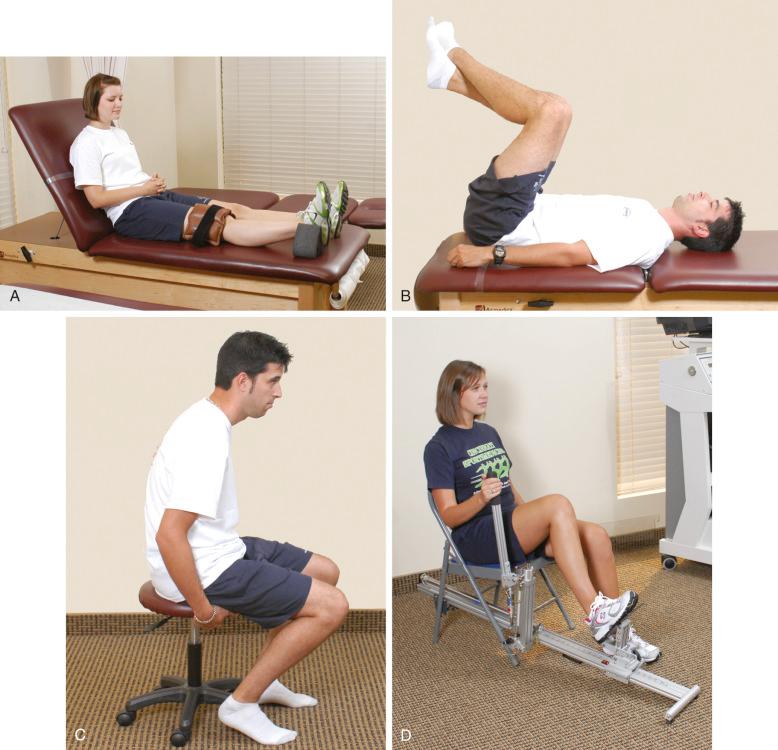
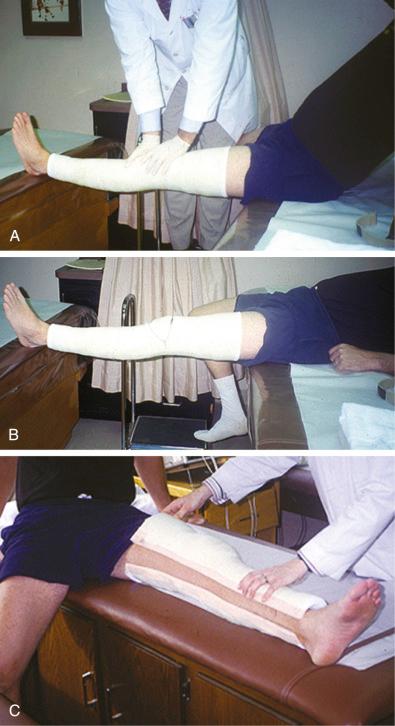
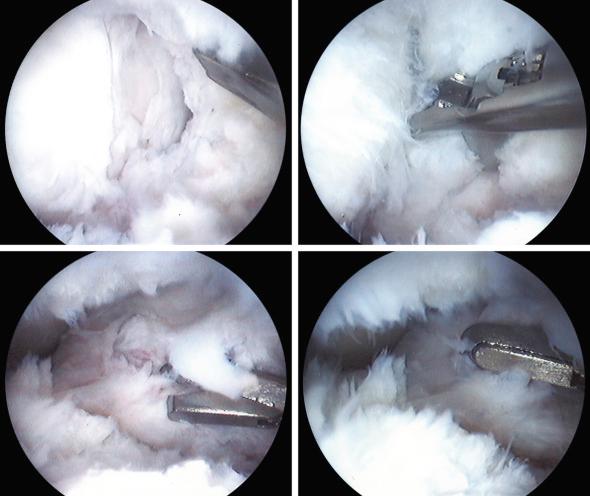
Although many authors have recommended early partial or full weight bearing immediately following ACL reconstruction, few studies have examined this factor and its potential effect on both short- and long-term recovery. The effect of immediate full weight bearing on the outcome in knees with noteworthy articular cartilage damage or those in which major concomitant operative procedures were required is unknown. In addition, gait abnormalities that may ensue from immediate full weight bearing owing to pain, knee joint effusion, and muscle weakness have not been examined. It does appear, based on the literature and our experience, that immediate partial weight bearing is safe and not deleterious to the healing ACL graft.
Ohkoshi and associates recommended early weight bearing after ACL reconstruction many years ago. These investigators used an analytical model to calculate shear forces placed on the tibia during standing at various trunk and knee flexion angles ( Fig. 10-4 ). The shear forces were posteriorly directed in all positions, which increased as trunk flexion angles increased (at knee flexion angles of 30 and 60 degrees). Cocontraction of the quadriceps and hamstrings was observed at all knee and trunk flexion angle positions, with increasing hamstring activity measured with increasing trunk flexion angles. Exercises performed in the standing position with the knees flexed and the trunk anteriorly flexed, such as half-squatting, were believed to not only be safe but also to have the potential advantages of increasing muscle strength, endurance, and proprioception and decreasing bone atrophy.
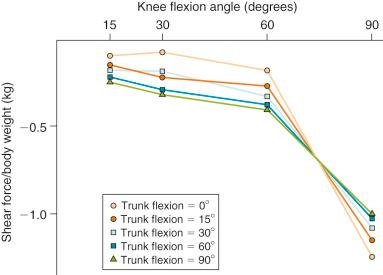
The effects of postoperative and functional braces on pain, return of normal knee motion, complications, sports activity performance, balance, and proprioception have been assessed by many investigators. Most studies report that braces do not provide significant benefit in achievement of normal (1) knee motion, (2) isokinetic lower-extremity muscle strength, (3) stability, (4) lower limb symmetry on single-leg hop tests, and (5) functional knee rating and activity level scores. In addition, in systematic reviews and consensus statements, high-quality evidence has not been found to support the routine use of functional or rehabilitative bracing after ACL reconstruction. In our experience, a postoperative brace is beneficial in select patients early after surgery for protection and comfort, as discussed in Chapter 11 .
Unresolved problem, studies report deficits ranging from 5%-40% for quadriceps, 9%-27% for hamstrings.
Several theories for atrophy and strength deficits; may occur bilaterally.
Changes in muscle fiber composition, abnormal gamma loop function; arthrogenic muscle inhibition commonly cited.
Lower-extremity muscle atrophy and weakness after ACL reconstruction represents a difficult and unresolved problem. Investigators have reported postoperative strength deficits ranging from 5% to 40% for the quadriceps and from 9% to 27% for the hamstrings. Unresolved postoperative muscle strength deficits may be associated with knee osteoarthritis that is present either at baseline or years after surgery. A recent study found that quadriceps strength predicted 61% the variance in self-reported disability (according to the IKDC Subjective Knee Form) an average of 4.5 years postoperatively in a small group of 15 patients.
The factors related to the loss of muscle size and strength after ACL reconstruction remain unclear. Studies vary considerably in terms of patient age, preoperative and postoperative activity levels, time elapsed since surgery, ACL grafts, rehabilitation programs, concurrent operative procedures, and methods used to determine muscle size and function. For instance, in one recent study, researchers compared 15 patients who underwent ACL reconstruction (who were 2-15 years postreconstruction) with 15 controls, all of whom were “active” people (Tegner activity scale score ≥4), between 19 and 38 years of age. Problems with muscle atrophy appear to occur regardless of the type of graft used to reconstruct the ACL and frequently occur bilaterally. The proposed reasons for quadriceps muscle strength deficits that persist after surgery include:
Selective atrophy of type 1 fibers.
A reduction in muscle fiber size.
Hypertrophy of fast-twitch muscle fibers.
Nonoptimal activation of muscles during voluntary contractions.
Loss of native ACL mechanoreceptors that result in abnormal (decreased) gamma loop function.
Arthrogenic muscle inhibition: Inhibition of muscle tissue from joint effusion and soft tissue damage leads to altered afferent output from knee joint and muscle atrophy.
Peripheral changes in muscle-tendon units of the quadriceps muscle, including chronic atrophy, changes in the compliance of the series elastic components of the muscle-tendon units, and alterations in structure and fiber type.
Elevated levels of atrophy-inducing signaling cytokines such as myostatin and transforming growth factor-β.
Alterations in neural pathways.
A combination of the above.
Regardless of the cause of muscle atrophy and weakness, it is paramount that the rehabilitation program correct the deficits in a controlled, effective, and safe manner. There are several principles the therapist must use to achieve this goal, which change as the patient progresses through the program. Modifications will be required based on the factors addressed in Table 10-1 . Adequate muscle strength is required to initiate more advanced neuromuscular exercises and, eventually, sports-specific activities. At our center, patients are seen 24 hours after surgery to begin initial muscle-strengthening and knee motion exercises.
Protect patellofemoral joint, avoid leg extension 0-30 degrees, exercises involving high knee flexion angles (deep squats, stairs).
Prefer closed kinetic chain exercises 0- to 50-degree range to minimize patellofemoral forces.
Control joint effusion to prevent reflex inhibition of quadriceps.
Electrical muscle stimulation, biofeedback are good adjuncts early postoperatively.
Use knee extension 50-100 degrees, single-leg and two-legged squats, wall squats, lunges, leg press machine, stationary bicycle initial postoperative phase.
Single-leg squat, straight-leg raise, heel raises, single-leg stance safe for healing anterior cruciate ligament graft.
Eccentric training appears advantageous, further studies required to determine safety.
Motor imagery should be explored early postoperatively to enhance muscle activation.
It is critical as one attempts to make gains in strength to avoid placing high forces on the patellofemoral joint throughout the rehabilitation process. Anterior knee pain that develops after ACL reconstruction is a difficult complication, and it is essential that the therapist understand the impact that exercises have on the patellofemoral joint. Patients who develop patellofemoral symptoms postoperatively must be carefully followed and the rehabilitation program altered as required to avoid activities that place high forces on the patella. We recommend avoidance of the leg extension machine (an open kinetic chain [OKC] exercise) in the range of 30 to 0 degrees of knee flexion, as well as exercises that involve high knee flexion angles such as deep squatting, kneeling (past 50 degrees) and extensive stair climbing, in the first 3 months after surgery. The advice to avoid leg extensions in low knee flexion angles was first given many years ago in a cadaveric study conducted in our laboratory that measured the forces incurred on the extensor mechanism that developed during an OKC knee extension simulated exercise. The investigation demonstrated that the quadriceps force required to extend the knee remained at a constant value between 60 and 15 degrees of knee flexion and then rose rapidly. The addition of a small amount of resistance (31 N) doubled the quadriceps force that was required to extend the knee, resulting in large forces on the patellofemoral joint.
Steinkamp and associates calculated patellofemoral joint reaction forces in 20 healthy subjects at 0, 30, 60, and 90 degrees of knee flexion during a closed kinetic chain (CKC) leg press exercise and an OKC leg extension exercise. Reaction forces were significantly greater ( P < .001) at 0 and 30 degrees in the OKC leg extension exercise than during the leg press exercise ( Fig. 10-5 ). The opposite was true at the high knee flexion angles, for which forces were significantly greater in the leg press exercise. The authors concluded that the leg press placed minimal stress on the patellofemoral joint in the functional ROM (low knee flexion angles).
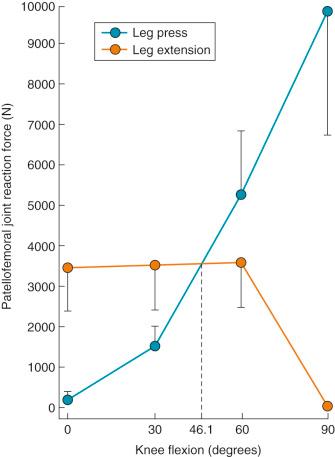
The stress on the patellofemoral joint depends not only on the load applied but also on the surface areas of the patella and femur that may be in contact at any given point in time. At 0 degrees of knee flexion, no or only minimal contact occurs between the patella and trochlear groove ( Fig. 10-6 ). With small amounts of knee flexion (20 degrees), contact occurs first on the distal portion of the patella with the proximal trochlea. As the knee flexes, the contact area moves proximally on the patella, whereas at 45 degrees, contact is on the central portion of the patella. Borotikar and Sheehan measured the in vivo contact area between the femur and patella using dynamic magnetic resonance imaging during knee flexion-extension and reported a mean of 125 mm 2 at 10 degrees of flexion, which increased to 229 mm 2 at 40 degrees of flexion. At 90 degrees, the superior portion of the patella is in contact with the trochlea. The greatest compressive forces occur in 60 to 90 degrees of flexion. Investigators have estimated that the loads on the patellofemoral joint range from 3 times body weight (BW) with stair climbing to 7 times BW with squatting to up to 20 times BW with jumping.
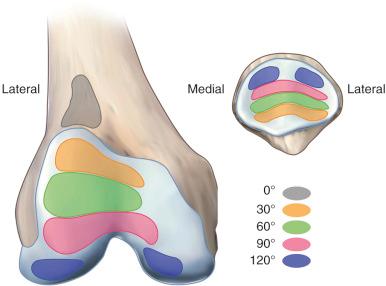
In regard to stair climbing, Goudakos and colleagues reported that, compared with level walking, this activity resulted in greater patellofemoral mean and peak pressures ( P = .01), patellar contact area ( P = .02), and patellar tilt ( P = .02). These differences were recorded when the knee reached 30 degrees of flexion. At a lower knee flexion angle of 12 degrees, stair climbing resulted in a significantly higher peak patellofemoral pressure, lateral patellar tilt, and amount of lateral force distribution on the trochlea ( P = .01). These authors concluded that their findings explained the association of stair climbing with patellofemoral pain.
Doucette and Child measured patellar congruence in patients with symptomatic lateral patellar compression syndrome with the lower extremity relaxed, holding an OKC knee extension position, and holding a CKC exercise position. During all three conditions, patellar congruence progressively improved with knee flexion. The authors concluded that a quadriceps contraction had less influence on patellar tracking at 30 degrees of flexion than at 0 degrees of flexion owing to the increased stability of the patella as it moved into the intercondylar groove as the knee was flexed. In low ranges of knee motion, CKC exercises were recommended owing to the improved patellar positioning and decreased joint irritation in symptomatic patellofemoral patients. This advice was more recently supported in a systematic review of exercises for patellofemoral pain by Harvie and associates. Some examples include minisquats (to 45 degrees of knee flexion), wall sits (to 50 degrees of flexion), lateral step-ups, and forward step-ups. Escamilla and associates measured patellofemoral compressive forces during a CKC wall squat exercise in healthy subjects. The forces ranged from approximately 75 to 1400 N between 0 and 50 degrees of knee flexion and then rose to approximately 2100 to 3650 N between 60 and 90 degrees of knee flexion. This compares to compressive forces incurred on the patellofemoral joint during walking of approximately 900 N. A series of studies led Escamilla and colleagues to recommend CKC training within 0 to 50 degrees of knee flexion to minimize patellofemoral and cruciate ligament forces.
A knee joint effusion may precipitate reflex inhibition of the quadriceps, leading to weakness and atrophy. Several investigators documented that quadriceps muscle inhibition occurred following an experimentally induced knee joint effusion and produced alterations in normal function during walking, jogging, and landing from a jump. Therefore it is imperative that knee joint effusions be avoided or treated immediately to lessen deleterious impact on quadriceps function. Joint aspiration, cryotherapy, transcutaneous electrical nerve stimulation, and compression are effective therapeutic measures. Prudent, short-term use of nonsteroidal antiinflammatory medications may also be required.
Neuromuscular electrical muscle stimulation (EMS) and biofeedback are recommended early after surgery in modern ACL rehabilitation protocols (see Chapter 11 ). Studies conducted several years ago demonstrated that EMS combined with active exercise was more effective than active exercise alone in recovery of quadriceps strength and normal gait mechanics. Fitzgerald and associates reported modest (effect size, 0.48) improvements in quadriceps isometric peak torque 16 weeks after ACL reconstruction when an EMS training protocol was incorporated into the postoperative rehabilitation program of 21 patients. Twelve weeks postoperatively, the experimental group demonstrated significantly greater quadriceps isometric peak torque index compared with that of a matched group of patients who did not receive EMS training (75.9 ± 16.8 and 67.0 ± 19.9, respectively; P < .05). However, no significant differences were measured at 16 weeks postoperatively between these groups. A greater proportion of the EMS-trained subjects initiated agility training at 16 weeks compared with the control group (62% and 32%, respectively; P < .05). Although high-level modern quality studies are lacking, Wright and associates concluded on the basis of a systematic review that high-intensity EMS may help achieve improved quadriceps strength after ACL reconstruction. In a more recent review, Imoto and colleagues concluded that EMS added to conventional exercises may be effective in improving muscle strength and recovery 2 months after surgery.
Biofeedback therapy has been suggested as a useful therapeutic technique in overcoming muscle inhibition early postoperatively. This therapy helps patients develop and increase their voluntary control over muscle contractions. However, no high-level studies have been conducted to ascertain the effectiveness of biofeedback following ACL reconstruction in regard to increases in muscle strength and/or reduced quadriceps atrophy.
Become a Clinical Tree membership for Full access and enjoy Unlimited articles
If you are a member. Log in here